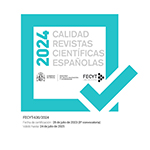Ley, deseo y libertad. Notas sobre Lacan y la Crítica de la Razón práctica
Abstract
The subversion of tradition of ethics carried out by Kant in his Critique of Practical Reason is, according to Lacan, the intelligibility background on which it is possible a science of the subject as developed by Freud. This would be shown up in a particularly effective way if comparing Kant’s moral theory with Sade’s antimoral one. It is not difficult to show the formal-structural identity of the state of affairs established by inconditionality of law in both theoretical systems, and thus expose the possibility of that anti-moral as a kind of Kantian variation. Moreover, Lacan holds, it is necessary to recognize in Sade’s Philosophy in the Bedroom the truth of Critique of Practical Reason. Our study proposes an examination of this well-known Lacanian thesis. On the one hand, we seek to establish the exact content of this thesis and the diagnosis of the relationship that it involves between Kant and Freud (between Enlightenment and psychoanalysis). On the other hand, we seek to confront that diagnosis with the reconstruction of the specific terms of the practical subject question in Kant’s philosophy. The ultimate aim is at least to raise a question about the place of the concept of “Reason” in psychoanalysis, that is, about the margin that the truth of the subject discovered by this theory leaves for making the difference (at least de iure) between the weight of reason and the illusions of moral masochism, and about the very conditions of psychoanalysis as a theory.Downloads
Article download
License
In order to support the global exchange of knowledge, the journal Logos. Anales del Seminario de Metafísica is allowing unrestricted access to its content as from its publication in this electronic edition, and as such it is an open-access journal. The originals published in this journal are the property of the Complutense University of Madrid and any reproduction thereof in full or in part must cite the source. All content is distributed under a Creative Commons Attribution 4.0 use and distribution licence (CC BY 4.0). This circumstance must be expressly stated in these terms where necessary. You can view the summary and the complete legal text of the licence.











